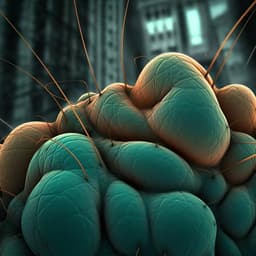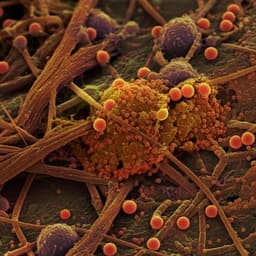
Earth Sciences
Microbial necromass carbon and nitrogen persistence are decoupled in agricultural grassland soils
K. M. Buckeridge, K. E. Mason, et al.
This intriguing study by Kate M. Buckeridge and colleagues explores the role of microbial necromass in soil carbon dynamics. Discover how its persistence compares to plant litter and the impact of management practices in grasslands on carbon sequestration. Delve into the surprising findings of carbon mineralization and its implications for agricultural sustainability.
~3 min • Beginner • English
Introduction
Soils store large stocks of carbon and nitrogen, particularly in grasslands, where land-use intensity influences soil organic carbon (SOC) stocks. Microbial residues (necromass) form a substantial portion of persistent soil organic matter (SOM), mediated by microbial ecology and soil mineralogy. Yet, the extent to which microbial necromass persists relative to plant litter, the balance between microbial recycling and mineral-association, and the rates at which mineral-associated necromass C and N are lost remain unclear. This study addresses three uncertainties: (1) whether substrate type (microbial necromass vs. plant litter) affects formation of persistent soil C; (2) how much necromass C and N are recycled versus mineral-associated; and (3) the rate at which mineral-associated necromass C and N are lost from mineral surfaces. The work tests hypotheses related to substrate C:N and quality, rapid abiotic sorption to minerals, microbial mining, and how agricultural management intensity moderates these processes.
Literature Review
Prior work shows microbial necromass can dominate or substantially contribute to persistent SOM, with formation and stabilization influenced by microbial traits, abiotic conditions, and critically by soil mineralogy and organo-mineral interactions. Adsorption to mineral surfaces can be immediate and substantial and is often a key step in stabilization. Microbial metabolism can both form and degrade mineral-associated necromass via recycling and mining. Substrate chemistry (e.g., C:N ratio) influences decomposition rates, though its role as a universal predictor is debated. Management intensity alters plant and microbial communities and nutrient dynamics, potentially affecting SOM persistence. Nitrogen-rich microbial products may preferentially sorb to minerals (e.g., proteins vs polysaccharides), suggesting necromass N could be especially persistent. However, the relative roles of rapid abiotic sorption, microbial uptake and turnover, priming, and environmental drivers (moisture, aggregation, bioturbation) remain incompletely quantified, and the fate of necromass N alongside C is a key knowledge gap.
Methodology
Study site: Clay loam agricultural soil (Chromic Eutric Albic Stagnosol; sand 53%, silt 19%, clay 28%; pH 6.7) at Myerscough College Experimental Farm, NW England (53°50′57″N, 2°47′01″W, 10 m asl). Climate: mean annual max 14 °C, min 6 °C, precipitation 1034 mm. Two juxtaposed pastures: high-intensity (historically 247 kg N ha−1 yr−1 slurry/manure, 2–3 mows yr−1, 0.21 LU ha−1 yr−1; %C 4.8, %N 0.48) dominated by Lolium perenne, Poa trivialis, Stellaria media; and low-intensity (unamended >35 yr; %C 6.7, %N 0.63) with tall grasses and forbs. Plots (n=5 per field) were arranged in blocks with 4 subplots each; land-use management was halted during the experiment. Microbial communities differed between land uses based on prior 16S and ITS data.
Laboratory incubation: Soils (0–10 cm) from both land uses were composited per plot (n=5), sieved (2 mm), adjusted to 60% water-holding capacity, and incubated (140 g dw equiv per jar) at 15 °C in the dark for 349 days. Treatments: dual 13C15N-labelled Escherichia coli necromass, labelled Lolium perenne leaf litter, labelled L. perenne root litter, and controls. Labels: leaf (1.9547 atm% C, 1.1070 atm% N), root (1.9077 atm% C, 0.7591 atm% N), necromass (1.9608 atm% C, 1.3398 atm% N). Additions were normalized to equal C input (5.34 mg C g−1 soil) with differing N inputs (leaf 0.47, root 0.14, microbial 1.55 mg N g−1). Headspace gases were sampled over 24 h on days 1, 7, 34, 65, 93, 118, 153, 189, 217, 294, 349; CO2 and N2O concentrations and isotopic compositions were measured. At end, soils were physically fractionated to quantify C and N in the fine mineral-associated fraction (<53 µm).
Field experiment: Highly 13C/15N-enriched E. coli necromass (≈99 atm% C and N) was injected as a suspension (140 mg dw per 20 cm-diameter collar; 2139.04 mg C m−2, 619.25 mg N m−2) into the top 1–3 cm of soil within PVC collars installed 2 months prior (10 cm above and below ground). Treatments: high- vs low-intensity pasture; necromass vs water control; time points at 3, 21, 92, 238 days after addition (destructive sampling; n=5 blocks per land use). Gas fluxes (CO2, N2O and isotopes) were measured periodically (4 Jul, 6 Jul, 24 Jul, 21 Aug, 3 Oct, 5 Dec, 26 Feb) with chamber methods and CRDS analyzers. Soils were destructively sampled at 0–5 and 5–10 cm at all time points, and 10–20 cm at 238 days. Microbial biomass C and N (MBC/MBN) and isotopic incorporation were quantified via modified chloroform direct extraction, followed by TOC/TN analysis and isotope measurements. Mineral-associated pools were quantified by dispersing aggregates (shaking, sonication at 440 J cm−3), sieving, and analyzing the <53 µm fraction for C, N, δ13C, δ15N. Isotopic mass balance used mixing models converting δ to atm% to calculate substrate-derived fractions in gases, microbial biomass, bulk soil, and mineral-associated pools. Statistics: lab and field pools and fluxes were tested via two-way ANOVA (lab) and linear mixed-effects models with AR(1) correlation (field) to assess effects of land use and time. Mean residence times were estimated from exponential decay fits to log-transformed pool sizes (inverse slope).
Key Findings
Laboratory incubation (1 year):
- Microbial substrate mineralization (CO2 and N2O) showed a preference of leaves > necromass > roots (Fig. 2a,b), contrary to expectations based on C:N alone. Bulk soil retained more C from roots than from necromass (P = 0.0008) or leaves (P = 0.0085), with no consistent N differences across substrates.
- Despite higher mineralization of leaves, mineral-associated C after 1 year did not differ significantly between E. coli necromass and L. perenne leaf litter (Fig. 2d). Mineral-associated N was greater with roots than leaves (P = 0.032). Low-intensity soils accumulated more mineral-associated C (P = 0.0056) and N (P < 0.0001) than high-intensity soils.
Field experiment (238 days):
- Rapid sorption: Within 3 days, 64.1 ± 4.6% of added necromass C and 108.9 ± 5.7% of added necromass N were recovered in the mineral-associated fraction of the top 10 cm, indicating strong immediate abiotic interactions.
- Limited anabolic uptake: At 3 days, microbial biomass contained 2.1 ± 0.2% of added C and 4.7 ± 0.7% of added N (0–10 cm), with most in 0–5 cm; microbial uptake declined over winter, reflecting turnover.
- Respiration pulse: Necromass-derived 13CO2 peaked at day 3 (6.1 ± 0.6% of added C respired that day) and declined thereafter; no land-use effect on 13CO2. Cumulative 15N2O was small but higher in low-intensity plots (1.6 ± 0.8%) than high-intensity (0.2 ± 0.06%) (P = 0.021).
- Persistence vs loss: Over 238 days, mineral-associated necromass C declined substantially, consistent with microbial mining, whereas mineral-associated necromass N persisted. Across 0–10 cm, mean residence times were approximately 330–422 days for C and 727–4211 days for N, with a trend toward longer C retention under high-intensity management (P = 0.060). In 5–10 cm soils under high-intensity management, no detectable loss of mineral-associated C or N was observed, whereas low-intensity soils showed significant decay.
- End-of-study pools (0–20 cm): After 238 days, 37.1 ± 1.9% of added C and 105.2 ± 6.3% of added N remained in mineral-associated pools.
Synthesis: Decomposition rates (substrate preference) did not predict long-term mineral-associated C formation; necromass C is less persistent than necromass N; management intensity modulates both rapid mineral-association and subsequent destabilization, with notable depth-dependent effects.
Discussion
The findings address the core questions by showing that higher initial mineralization (leaves) did not translate into greater or lesser long-term mineral-associated C compared with microbial necromass, challenging assumptions that substrate complexity and C:N alone determine stabilization. Field tracing demonstrated that necromass rapidly becomes mineral-associated, consistent with strong abiotic sorption, but that the associated C is subsequently mined more than N, evidencing a decoupling of C and N persistence. Management intensity influenced these dynamics: while low-intensity soils in the lab accumulated more mineral-associated C and N (absent plants), field rhizosphere processes under high-intensity management reduced both gains and losses at 5–10 cm and tended to extend C residence time across 0–10 cm. This suggests rhizosphere conditions, nutrient status, and depth distribution strongly regulate stabilization and destabilization. The persistence of mineral-associated necromass N relative to C may underpin N accumulation in agricultural grasslands and has implications for N cycling and greenhouse gas dynamics. Overall, the results support a framework where necromass transitions through production, rapid stabilization, and variable destabilization stages governed by both biotic (microbial mining, community composition) and abiotic (mineral interactions) controls, which should be explicitly represented in ecosystem models.
Conclusion
This study demonstrates that microbial necromass and plant litter decompose at different rates, but these differences do not necessarily predict long-term mineral-associated C formation. In situ, necromass rapidly sorbs to minerals, yet its C is preferentially lost relative to N over months, leading to a pronounced decoupling of C and N persistence. Agricultural management intensity and depth modulate both stabilization and mining processes, with evidence for reduced loss and longer residence times under high-intensity management in sub-rhizosphere soils. These insights refine understanding of SOM formation and persistence, suggesting that strategies to enhance soil C sequestration should minimize microbial mining of mineral-associated necromass C while acknowledging the greater persistence of necromass N. Future research should: (1) disentangle species and chemical effects of diverse microbial and plant residues on stabilization; (2) resolve microscale spatial pathways (in situ biofilm vs dispersed necromass) and the role of the necrobiome; (3) quantify seasonal necromass production via amino sugar dynamics; and (4) incorporate explicit mineral–organic interactions and C–N decoupling into ecosystem models for improved prediction of soil C storage under varying management regimes.
Limitations
- Substrate simplification: A single bacterial taxon (E. coli) and a single plant species (Lolium perenne) leaf and root litter were used as proxies and may not represent natural chemical diversity; species-specific effects, especially for fungi, are not captured.
- Delivery mode: Injected necromass suspension may not mimic in situ locations or microenvironments of microbial death (e.g., within biofilms), potentially quantifying only part of necromass pathways.
- Temporal scope: Field observations spanned ~8 months; longer-term dynamics and multi-year stabilization/destabilization cycles were inferred via exponential decay models that assume homogeneous pools.
- Pool modeling: Mean residence times were estimated from simple exponential decay; real systems likely comprise multiple interacting pools with recycling among them, and model structure can influence residence time estimates.
- Analytical gaps: High-frequency tracking of amino sugars or isotope dilution to quantify seasonal native necromass production was not performed; early period had no rain events, potentially affecting initial transport and sorption dynamics.
- Statistical power: Depth was analyzed in separate models due to power limitations; some trends (e.g., longer C residence under high-intensity) were marginal (P ≈ 0.06).
Related Publications
Explore these studies to deepen your understanding of the subject.







